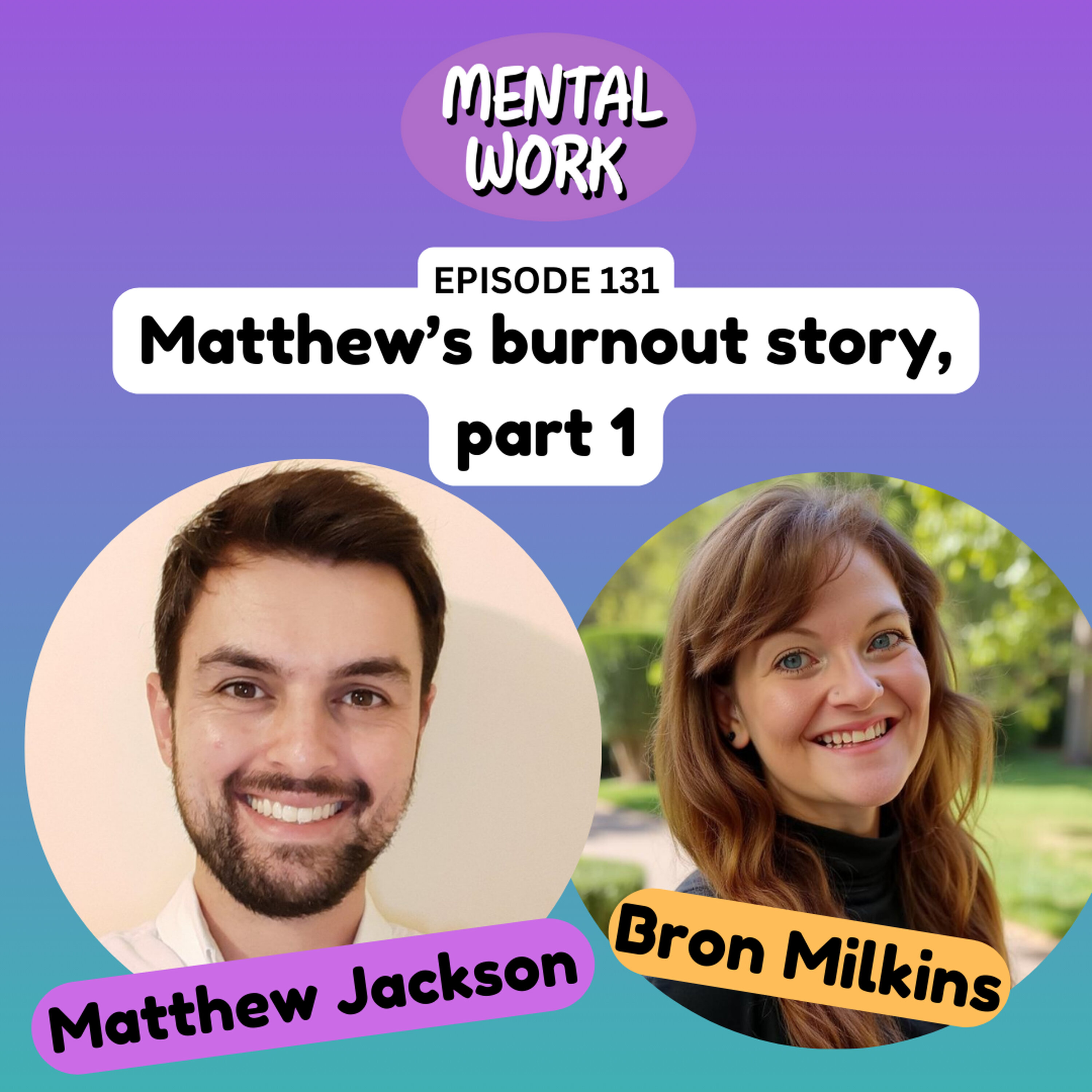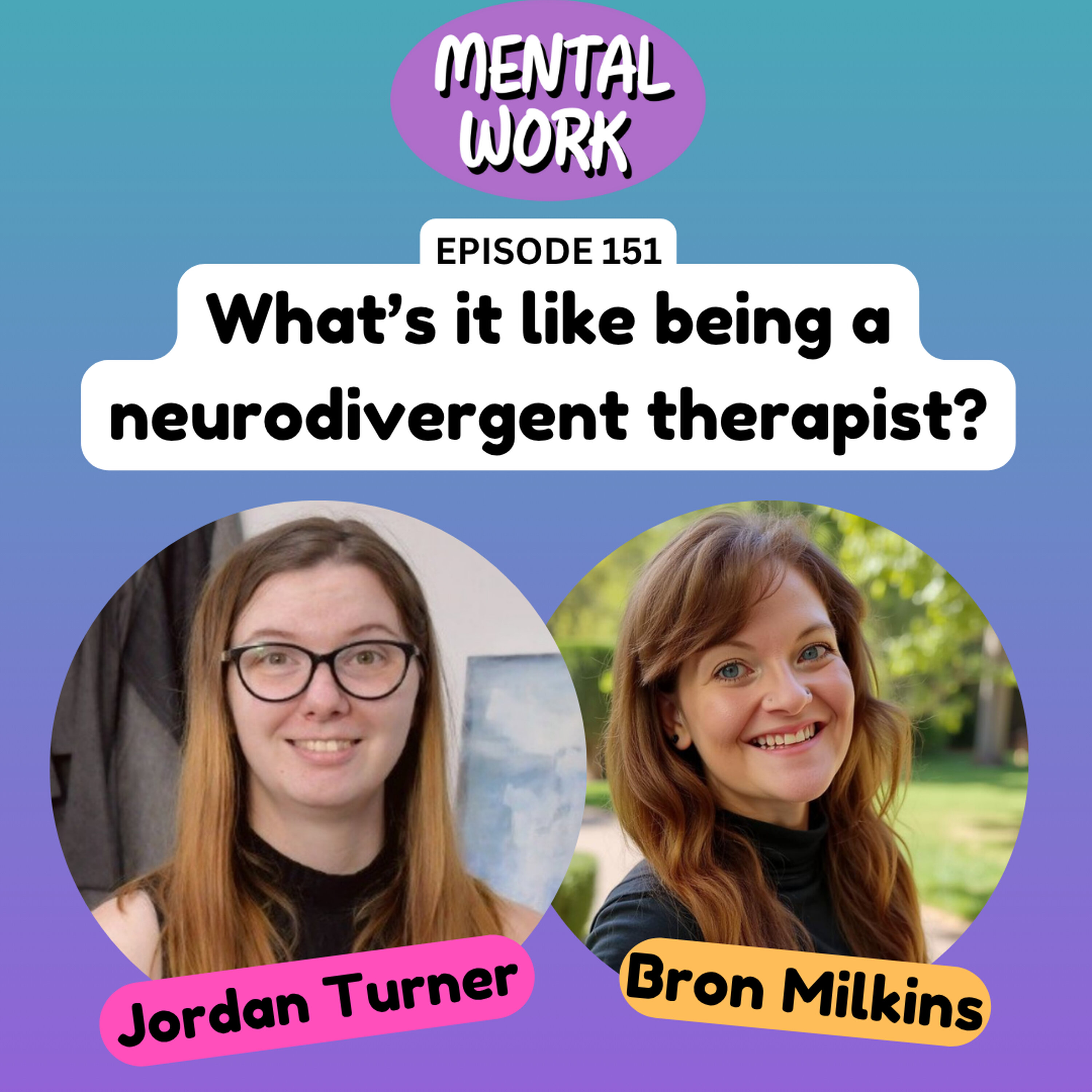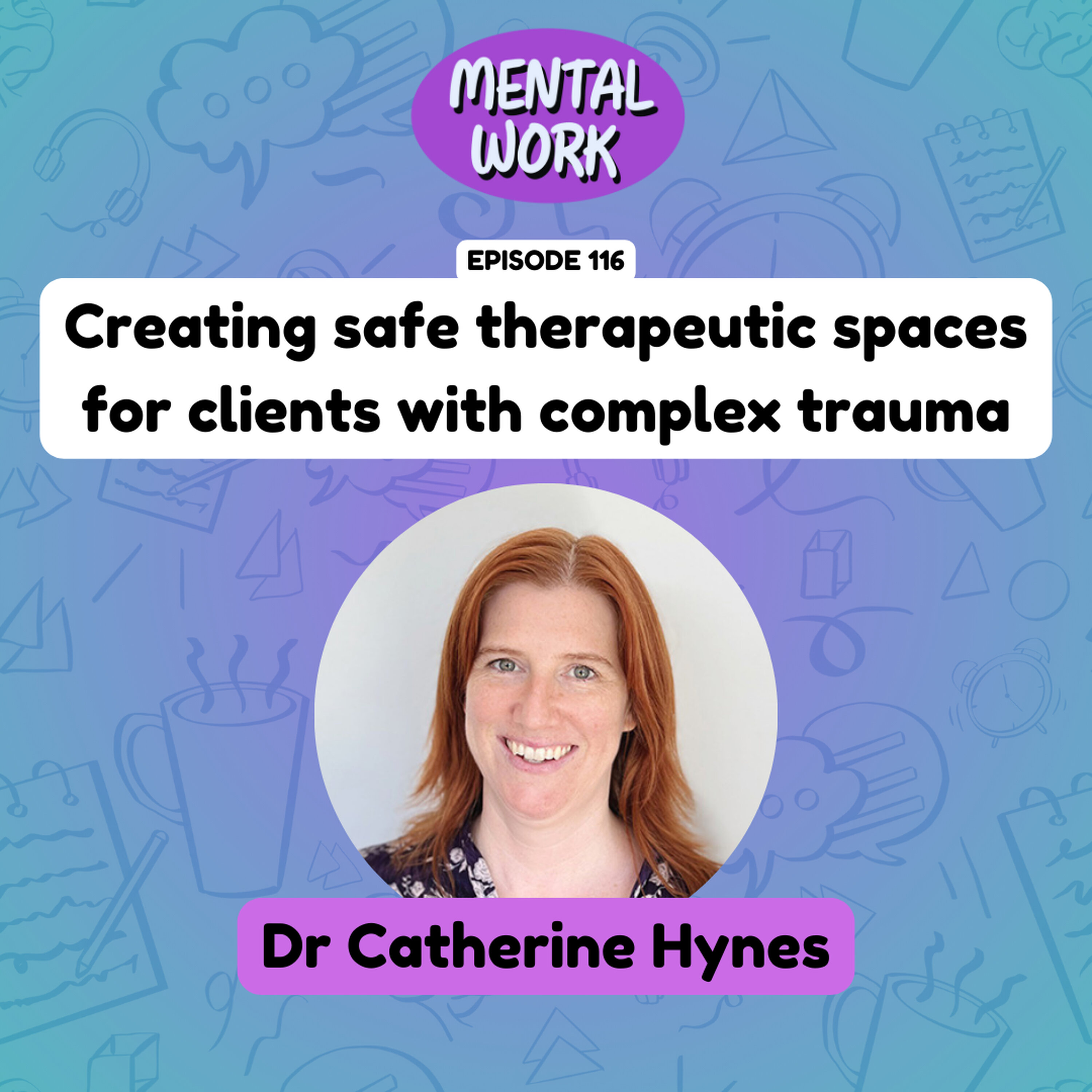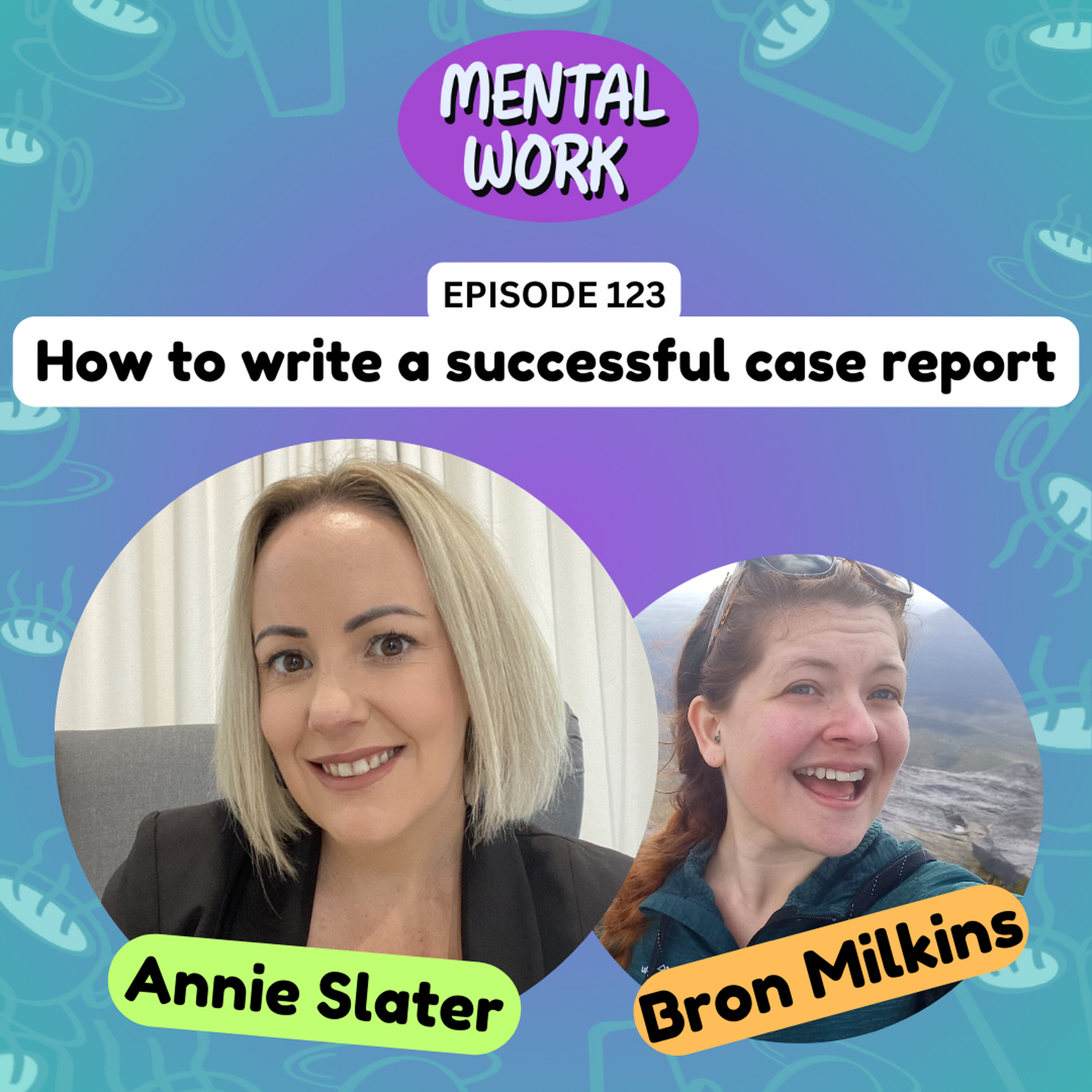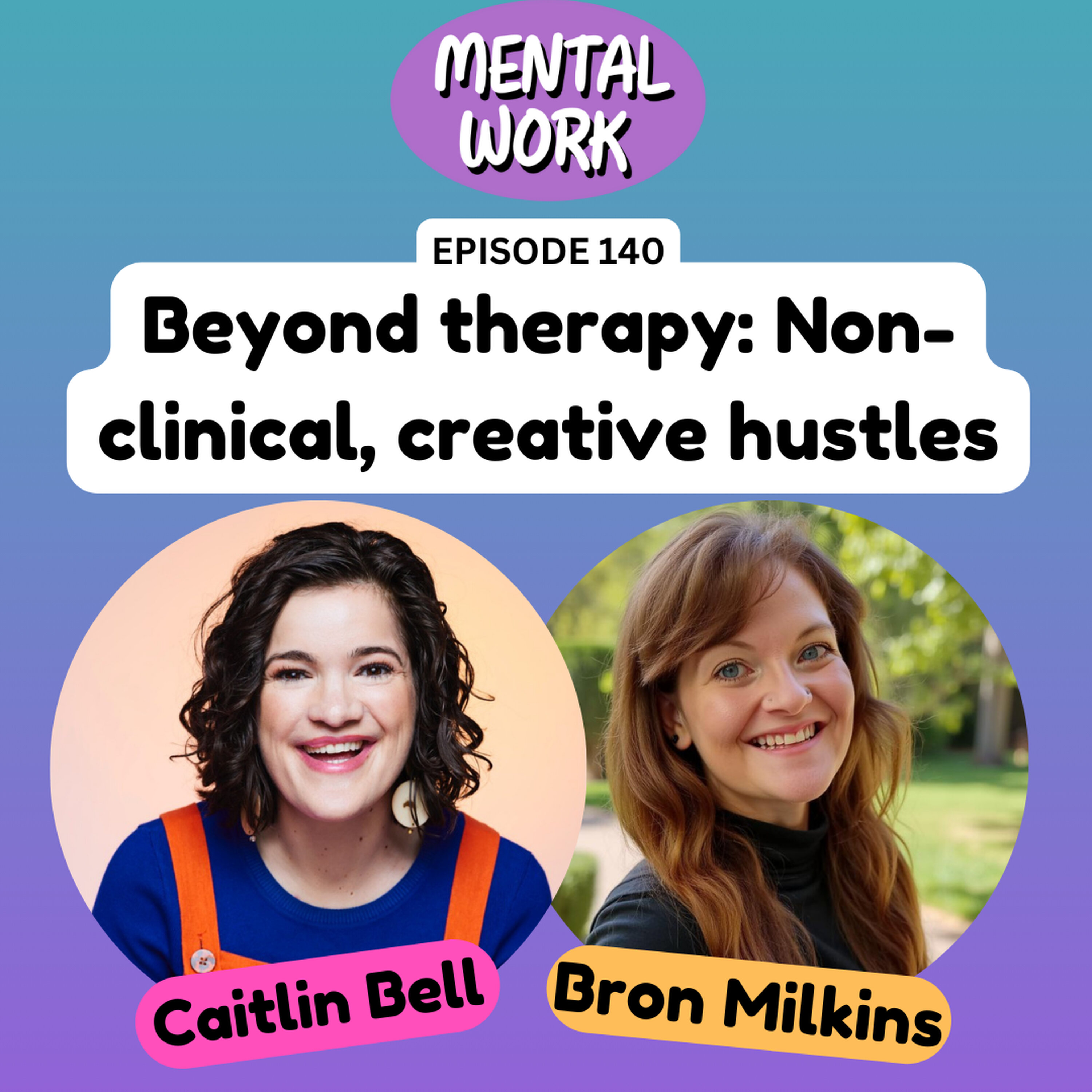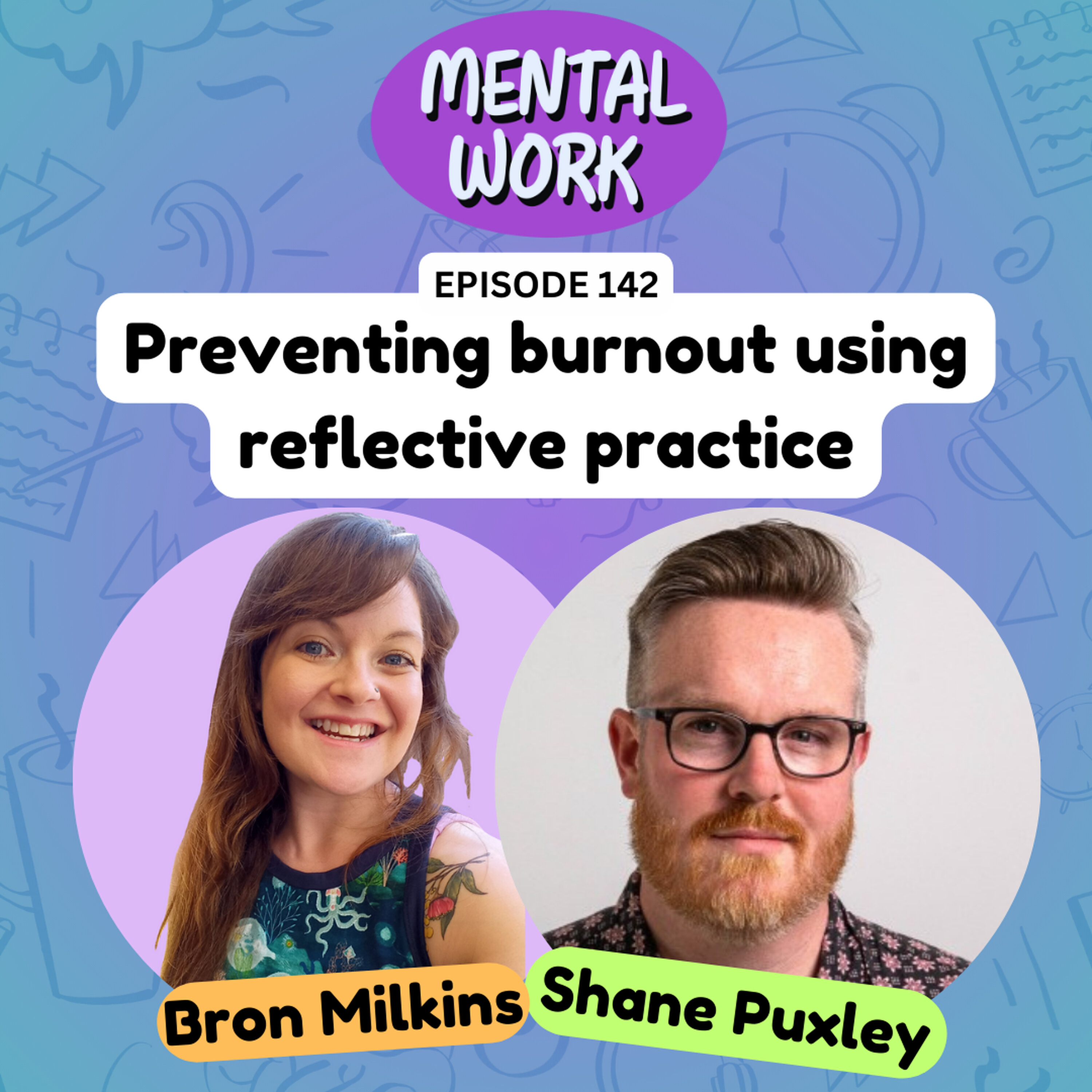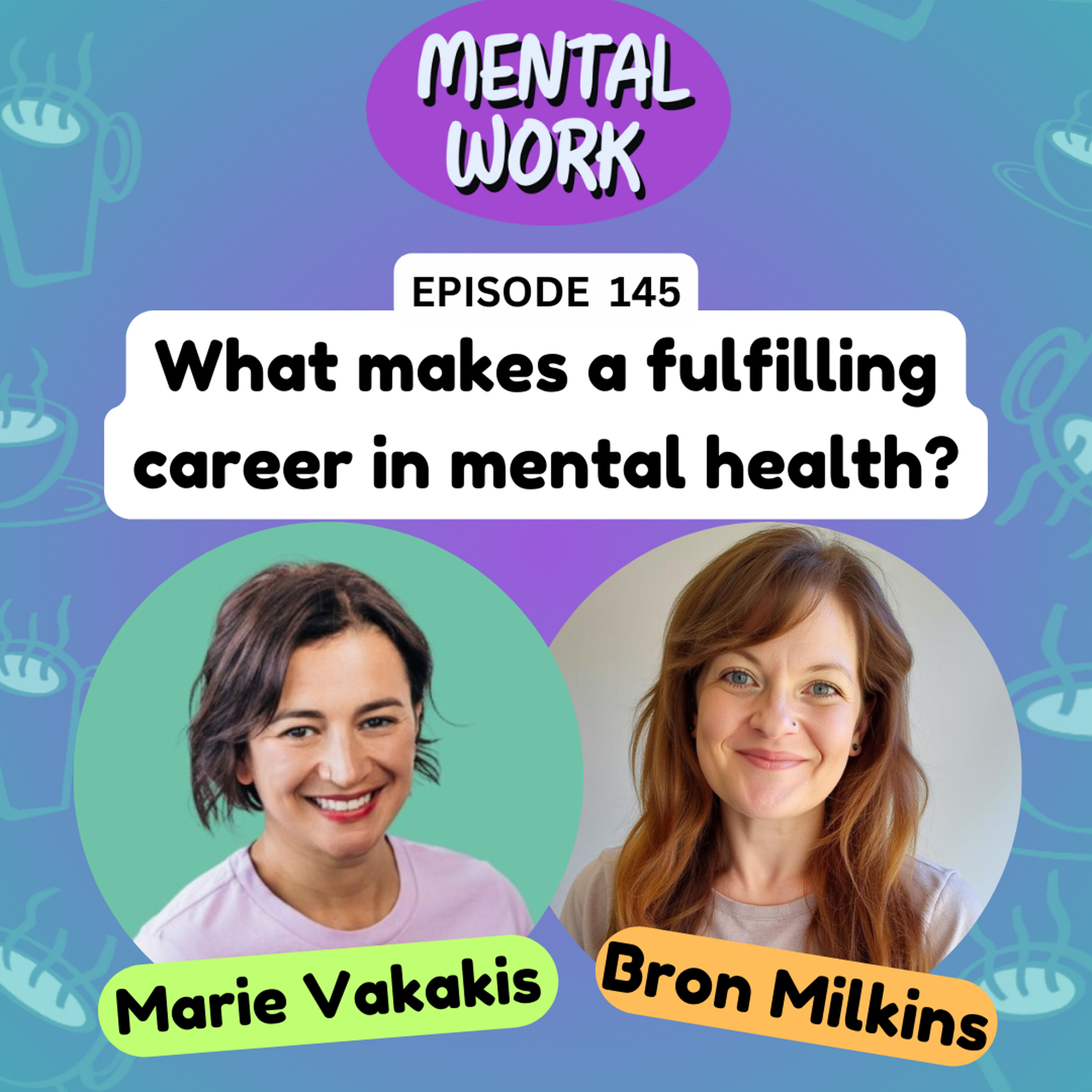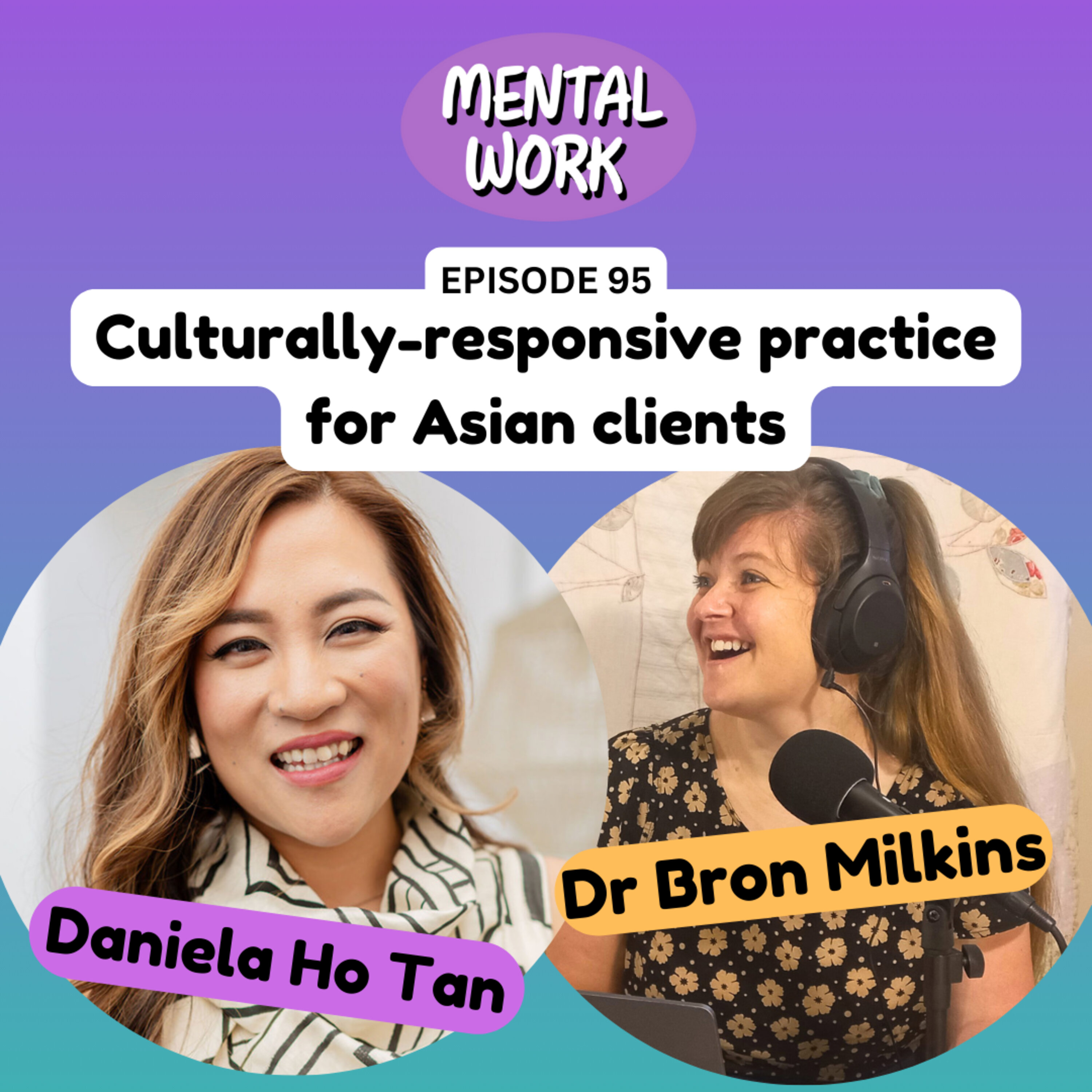Sensory modulation therapy & working as an occupational therapist (with Emma Craske)

We welcome our first occupational therapist guest, Emma Craske! 🥳 Bron and Emma chat about what it's like working as an OT before turning to Emma's passion topic, sensory modulation therapy. Emma talks about how sensory modulation can help clients with a range of challenges and gets specific about the techniques that might be used in a session. I really enjoyed learning about this creative and practical approach to helping client's feel safe and regulated, and hope you do too!
Guest: Emma Craske , Mental Health Occupational Therapist
LINKS
- Emma's Instagram
- Research article: Defining sensory modulation: A review of the concept and a contemporary definition for application by occupational therapists (2018)
- Research article: Efficacy of sensory interventions on school participation of children with sensory disorders: A systematic review (2018)
THE END BITS
Mental Work is the Australian podcast for mental health workers about working in mental health, with an early-career focus. Hosted by Bronwyn Milkins .
Support the show by buying me a virtual coffee ☕🍵
Have a question, episode idea or just want to say hi? DM Bron on Instagram or email mentalworkpodcast@gmail.com
Apply to be a guest / YouTube (with captions & transcript) / Website
CREDITS
Producer: Michael English
Music: Home
Commitment: Mental Work believes in an inclusive and diverse mental health workforce. We honor the strength, resilience, and invaluable contributions of mental health workers with lived experiences of mental illness, disability, neurodivergence, LGBTIQA+ identities, and diverse culture and language. We recognise our First Nations colleagues as Traditional Custodians of the land and pay respect to Elders past, present, and emerging. Mental Work is recorded on unceded Whadjuk Noongar land in Boorloo.
Disclaimer: Mental Work provides informational content. Mental Work is not a psychological service and being a listener or guest does not establish a clinical or non-clinical relationship. Content should not be considered a replacement for professional consultation or therapy. All views expressed are personal, subject to change, and do not represent those of any affiliated service or organisation. Efforts are made to ensure accuracy, but opinions may not always align with fact. Listeners are encouraged to thoughtfully assess the information presented and report any inaccuracies or concerns via email . Further information can be found here .
See omnystudio.com/listener for privacy information.
[00:00:04] Bronwyn: Hey, mental workers. You're listening to the Mental Work podcast, the podcast about working in mental health for mental health workers with an early career focus. I'm your host, Bronwyn Milkins, and today we are talking about sensory modulation in adults.
Early career mental health workers often support clients with emotion regulation and distress tolerance, but what if we're overlooking a powerful tool, the senses. Sensory modulation is a practical and evidence-based approach used by mental health occupational therapists to help people regulate their nervous system and their emotions. In this episode, we're going to be looking at what sensory modulation is, why it's relevant for mental health practice, and how you could integrate it into your work to help clients feel safer, more in control, and better equipped to navigate daily life.
Here to help us out is our guest, Emma Craske.
[00:00:54] Emma: Hi. Thank you so much.
[00:00:56] Bronwyn: It's a pleasure to have you on. Emma. Could you please tell listeners who you are and what your non-work passion is?
[00:01:02] Emma: Yeah, so I am a mental health occupational therapist. I have been working in this space for over five years now. I am truly passionate about sensory modulation. Um, but when I'm not working, my passion is my kittens. Uh, we got them not too long ago and I am just totally obsessed with them.
[00:01:23] Bronwyn: So you've got two or more?
[00:01:26] Emma: Two kittens.
[00:01:27] Bronwyn: Wow. How old are they now?
[00:01:29] Emma: Uh, they're about 10 weeks.
[00:01:31] Bronwyn: Oh wow. They're, oh gosh. They're just little critters. That's so cute.
[00:01:34] Emma: Yeah. They're tiny babies.
[00:01:36] Bronwyn: That's adorable. And you know what, Emma? We've never had an occupational therapist on the podcast before. So you are our first OT.
[00:01:43] Emma: Oh, that's very cool.
[00:01:44] Bronwyn: Could you tell us what an occupational therapist does?
[00:01:48] Emma: Yeah, so occupational therapists are very focused on function. Uh, we always have an overarching goal, uh, which is very focused towards helping people improve their function and therefore their quality of life and how they go about their day to day.
I work in this space of mental health, which basically means that we assist people who have a diagnosis in mental health or neurodivergent, and we have the overarching goal of building their function and improving their daily life, uh, through therapies like sensory modulation that help them to regulate their emotions and therefore their behavior.
[00:02:28] Bronwyn: Yeah, because I think one thing that I was confused about OTs early on in my career was I thought they just helped people with work. Like I thought the occupation was work and then I had to learn that you, you guys see everything that people do as occupations.
[00:02:44] Emma: Yes, definitely. Um, we break it down into occupations and roles, so it's like, what is everything you do in your daily life and what are your roles that you carry in your daily life as well? So we try to target that to prove, I guess, like an overwhelming, um, sense of stability. It's all about that balance of taking into consideration someone's work life and their home life, and making sure they're, you know, stable amongst all of it.
[00:03:09] Bronwyn: Yeah, it's so cool. And you mentioned before that one area that you're really interested in is sensory modulation. How did you come to be interested in this?
[00:03:19] Emma: Well, I started my early career in mental health knowing that that was my passion. Uh, then I started working at NDIS and a big part of that is doing sensory assessments and sensory uh, reporting. I was introduced to it and I fell in love with it. I found that it just seemed to click for me, it felt very natural.
Then I decided to explore it a little bit more, um, and dive into it. I then moved into working in a inpatient mental health unit, and that's where it fully, sort of exploded and became very focused on adults, um, and then took it one step further in the mental health realm of it being symptom specific and really just like in depth, and now I've decided to the point where I'm ready to do it privately and hopefully, um, spread, spread the word.
[00:04:11] Bronwyn: Are you currently in private practice or is it something that you're going to be starting soon?
[00:04:16] Emma: I've started, so I've got a couple of clients, but I'm looking to build it up.
[00:04:20] Bronwyn: Yeah. And a key focus for that is sensory modulation therapy.
[00:04:25] Emma: Definitely that underpins all of the therapy I do with clients for sure.
[00:04:30] Bronwyn: Yeah. It's so cool. I think a lot of listeners could relate with what you said earlier, which was it just resonated with you. I think that's really cool when we find something and we're just like, oh, this makes sense.
But I think many people are unfamiliar with sensory modulation. Could you just tell us what it is and why it's important?
[00:04:49] Emma: So sensory modulation is the brain's ability to process and regulate internal and external stimuli. So these are things like sound smells, everything. Um, and sensory modulation involves using personalized sensory strategies to then regulate the nervous system. So it helps individuals manage stress, emotions, and just daily challenges effectively.
So when sensory modulation is disrupted, so when we're not in balance, individuals may experience difficulty such as overreacting or underreacting to sensory input, uh, leading to challenges in daily activities and, social interactions.
Um, so sensory modulation can literally help everybody on this planet. You don't need to have a mental illness for the therapy to be effective. Obviously when someone has a mental illness or neurodivergence, the impact of the sensory strategies are more profound. But the key is that you just need to be open to the process.
[00:05:53] Bronwyn: You mentioned folks who are neurodivergent. Are those people who you tend to see in private practice or, um, on the NDIS who, who want assistance with sensory stuff.
[00:06:04] Emma: Yeah, I think it is more commonly known that sensory modulation is helpful for neurodivergence, particularly because it is focused around regulating, um, the sensors. Um, but, and I guess it's like commonly seen in children, um, a lot of the time it's the go-to therapy for kids with autism or ADHD. So yeah, that, try to take that over into adulthood 'cause there is a lot of later life diagnoses.
[00:06:33] Bronwyn: Yeah, and it seems silly now that I'm thinking about it, that people think that it could only be helpful for kids when people who are, say, autistic adults, they may have, uh, sensory inputs that it distressing or challenging for them as well.
[00:06:45] Emma: Definitely, I think, um, adults need it just as much. They're just better at hiding it. We are better at hiding our dysregulation. If we're in a shopping center, we're not gonna fall to the floor and have a tantrum when we're overstimulated. If anything, we'll internalize it and maybe have a bit of a panic attack, or just sort of leave the shopping center really quickly. So you know, we need it just as much as kids. We're just better at hiding when we're dysregulated.
[00:07:13] Bronwyn: It's so true. That's so right. Like I'm in an office currently, like I'm working in an office and the lights annoy me so much and they just like really irritate my eyes. But it's not like I'm in front of my colleagues being like, oh, my eyes are so irritated. I literally take myself to a dark room away from everybody else.
[00:07:29] Emma: Yeah. That's so true.
[00:07:31] Bronwyn: Yeah.
[00:07:31] Emma: Yeah.
[00:07:32] Bronwyn: Um, so can sensory modulation also be helpful for people who experience like anxiety, depression, trauma, or is it mainly for neurodivergent folks?
[00:07:42] Emma: Definitely. Um, I think the biggest, one is trauma. So when people experience trauma, um, they sometimes develop hypervigilance, which is basically when they become overreactive to the environment around them. It's basically when they stick in this state of fight and flight, um, and, you know, they're constantly trying to be on high alert for any sort of dangers, um, in their environment because they just don't feel safe.
What we then do is help the individual to be able to feel safe and regulated in their own body using the sensory modulation. So this is a lot of soothing and calming techniques that we use. Um, and this is... we use similar for anxiety as well. So a lot of soothing and calming, um, to try regulate the nervous system and make them feel calm. Um, but for someone with depression, you're not gonna wanna use a soothing technique, you're gonna wanna use something that's going to pick them up, make them feel more alert and more motivated.
So it really depends on the diagnosis and what it is the aim of the therapy is, whether it's to soothe, whether it's to motivate an alert, um, that sense of safety. So it really just comes down to the individual person. But yes, definitely very helpful for everyonwith ahe mental illness. Yeah.
[00:09:07] Bronwyn: Yeah. No, that's really cool. And that makes a lot of sense to me. When I think about people with trauma. Sometimes in the few weeks after being exposed to a traumatic event, they can just be so hypervigilant. It's like their nervous system is just an overdrive. They've got a lot of cortisol, they're on alert for everything, and it sounds like sensory modulation could really help reduce that overwhelm.
[00:09:29] Emma: Definitely, yeah.
[00:09:31] Bronwyn: I find that when I'm talking about different therapies on the podcast, I find it really helpful to just make it tangible. And I'm wondering if we could go through what a session might look like with sensory modulation. Like if you tell us maybe a kind of example presentation and what, what a session might look like with a client like that.
[00:09:51] Emma: Yeah, definitely. I always start off by doing the sensory profile. It's basically a questionnaire that was created by Winnie Dunn, um, and you sort of go through, answer all the questions. Then I sort of take it away and interpret all of it and bring it back to the person with a bit of a report. We then sort of sit down and do a deep dive into, you know, this is your sensory profile. You know, it goes into what are your high thresholds, so needing more input, your low thresholds, where are you sensitive, and do that for each of the sensors, as well as looking at the behavioral response as well. Are you actively, responding to the stimuli, are you going to, you know, run away, uh, get violent, whatever it is, um, or you, you've got a more passive response and that can look like your dissociation, anxiety.
So it's very dependent on the person and you're sort of creating this overall, um, outline of them as an individual then is the fun part where you get to, sort of, do a deep dive into what that means for them. Usually this is then related back to their functional goal, so what area of their life do they want to improve, and then you tailor the sensory interventions to that. Um, but this can look like anything from developing a sensory box. Um, so it can be going through their sensors and working out, you know, where they need something that's maybe bright and colorful versus something that's helps reduce noise or something to fidget with something that's soft. It really depends on the person. You're just sort of creating something that they are going to find helpful in those times that they do feel stressed and overwhelmed.
Uh, I also do aromatherapy as well, which is using a lot of different essential oils and relating emotions to the sense, so that when you identify a negative emotion, say feeling sad, you identify a scent that makes you happy so that then when you are feeling sad, you can use that scent to help lift your mood up a little bit more. Um, and then it's going one step further and taking that scent that makes you happy and relating it to a, um, to a time. You know, it could be that peppermint makes you feel really happy and you have fond memories of having a cup of peppermint tea with your nana. And that helps you when you are feeling sad because you have that smell of peppermint.
[00:12:21] Bronwyn: What's your favorite smell?
[00:12:23] Emma: Have to be lavender.
[00:12:24] Bronwyn: Lavender. Oh God. What a great, such a great smell. 10, 10 outta 10. Yeah. I love lavender. I also really like lavender cake. Um, do you like lavender foods?
[00:12:34] Emma: I do, yes, big.
[00:12:37] Bronwyn: Man, I really love smells. So as you're talking that whole thing through, I was just thinking of one of my other favorite smells is 'cause I'm just weird, it's Vix Vapor Rub. I really love the smell of like eucalyptus and then you, when you are like connected to a memory, I'm like imagining myself sick. But I'm like, oh God, I love Vix.
[00:12:55] Emma: Yes. Yeah, that and like a good tea tree oil, so.
[00:12:58] Bronwyn: Yeah. Oh gosh. Lavender is so great as well. Is there any other strategies that you might use that are pretty typical?
[00:13:05] Emma: I then overlay it in with a lot of your classical therapies like your CBT, ACT, DBT and take components of it, uh, like your mindfulness from the ACT and interweave that with the sensory modulation, 'cause I find that if you combine the therapies you get the most out of them. So that would look like using a weighter blanket and then doing a grounding technique for some mindfulness, and that really helps to provide that, you know, physical element of it as well as the mental component of it. So you using your entire body to regulate yourself,
[00:13:41] Bronwyn: Are you trying to build people's tolerance to sensory import? Or is the goal something else? I guess like the way I'm thinking about it is, let's say that you have a client who works in a brightly lit office, which is open plan and it can be noisy. Is an aim of therapy to try to get them to just tolerate that more or is there something that... other than that, that's the aim.
[00:14:05] Emma: Ideally, you don't want 'em to have to tolerate it. If you can find alternatives in modifying the environment then I a hundred percent go down that pathway because I don't want people to have to sit with that dysregulation, especially if there's other alternatives or things that you can negotiate. Could be things like, uh, wearing glasses that sort of dim the lights, um, in the office. Or it could be having that conversation and having the lights reduced or using lamps instead of overhead lights. I really like that option. Um, if people are really sensitive to light. Um, so I find that as long as the person and the place is willing to have those discussions, uh, then there's usually always an alternative so that they can feel regulated in their environment.
[00:14:56] Bronwyn: Yeah, and I think that approach fits in more with the neurodiversity affirming approach, right? Like we're not trying to force people to sit through things that are really distressing and uncomfortable for them. If we can, we're trying to change the environment and then help them to regulate outside of that.
[00:15:11] Emma: Yes, definitely. It's, you know, you are using those regulation strategies because sometimes you can't eliminate all of the distressing environments around you. Um, but it's reducing it where you can and modifying it where you can so that we are not, so that we are creating more of an inclusive sort of environment for people.
[00:15:34] Bronwyn: So it sounds like with sensory modulation, I know you said you integrate it with other therapies as well, but it sounds like at the start of it, you're really explaining to clients like the importance of getting in touch with your body and how that feels to you. Is that broadly correct?
[00:15:50] Emma: Yeah, a lot of it is, uh, trial and error, I think, is the sort of overarching thing for sensory modulation is... it's a big experimental process and you have to learn a lot about your body, what feels right, what doesn't feel right. What, you know, comes across as somatic as well, because like we've been talking about the bright lights and that, um, that can commonly come across as, you know, eye strain, headaches, fatigue, um, fogginess. So it's learning to, um, also acknowledge and identify what are physical symptoms that your body displays as well when you are feeling dysregulated. So it is, it's definitely learning your body, how it responds, um, and doing a deep dive. So it is really cool in the way that you get to learn more about yourself.
[00:16:42] Bronwyn: Yeah, I, I really like this approach. Like I really am pro that because I think some people can get so disconnected from their bodies, or they're told that what their body is telling them is wrong. Like if people are sensitive, say to lights, they may have had somebody in their life say to them, oh don't be so precious, like it's not that bad, and then they learn to mistrust their bodies.
[00:17:04] Emma: Hmm. Definitely, and I think we see that a lot with, uh, things like dissociation trauma. There's a big disconnect from our bodies 'cause our bodies don't feel safe. So we need to sort of do the therapies and do the work to make our bodies feel safe again, so that we, you know, feel whole and happy as humans.
[00:17:25] Bronwyn: Yeah, and I think part of that, like if you're dissociating, it means usually that you're disconnected from your body and your surroundings, and it's like being able to say to yourself, okay, I, I can trust myself to tune into my body and respond in the way that I need to.
[00:17:38] Emma: Yeah, definitely. It's identifying it and then being able to utilize those strategies to bring yourself back to the present moment.
[00:17:47] Bronwyn: Yeah. I can, I can see why you really like this approach. Like I've never before, before I met you, literally, I haven't heard of this approach, but I'm like, I'm into this.
[00:17:54] Emma: Yeah, it's not commonly known, that's for sure. It's, uh, a niche area.
[00:17:59] Bronwyn: Is it well known amongst OTs? Like would, if I spoke to like every OT, would they know about it?
[00:18:05] Emma: I would hope so. Um, it is covered well, during my university studies it was covered. Very, very small amount was covered. Um, but they did touch on it. Um, and, they should know what it is? it's just when you branch out from OTs, um, that then it, uh, is a little less known.
[00:18:27] Bronwyn: No, I guess like, like as a psychologist, it's like the first thing we're taught about in uni is CBT, which is very much a thoughts influence the way you feel influence the way you behave. And then as you get out of it, like if you do further trauma studies, then you might come across like sensory motor therapy and polyvagal theory, and that's where they teach the bottom up the body approaches. But otherwise you don't really hear about those sorts of approaches.
And I guess that can be like, you know, CBT has its place, but for folks who are having sensory challenges or are in states of hypervigilance and hyper arousal, it might just not, I guess there's a missing ingredient for them in therapy.
[00:19:07] Emma: Yeah, definitely. It's all about working out what therapy is going to work for you. Um, even though I said before that sensory modulation could help anybody, um, you have to be willing open, ready, and it has to be for you. It might not resonate with someone, whereas CBT might resonate for them and vice versa. So it is really very personalized and I guess that's part of what we all love about therapy is that it's not one size fits all. Uh, you have to really find out what works for the person and sometimes it's trialing different therapies and yeah.
[00:19:45] Bronwyn: I just don't want people to feel like, oh, I tried CBT and it didn't work for me. Therefore, therapy won't work for me. I want people to know that they have lots of options available to them, and sensory modulation is one of them.
And I guess just how not many people know about it outside of OT, are there any misconceptions about sensory modulation that mental health workers should be aware of or they might be making themselves?
[00:20:08] Emma: I think the biggest one is that sensory modulation is just for children. I think it's very much at the moment, there's a lot of fidget toys and it's all tailored towards children. There's not a lot out there that. Uh, tailored towards adults. You can find them, but they're on sort of more niche websites and a little bit more expensive. Uh, but you can go to Kmart and find all the sensory toys that are targeted towards children. So a lot of people assume that it's just for children, but it's not. It's definitely for adults as well.
[00:20:42] Bronwyn: It is so true now that you say it because, okay, I'll tell you this story. So, I've got a basket full of fidget toys in my office and whenever I have people come into my office, like other psychs who, who might be looking to rent out my room, they're always like, do you see kids when they see the basket? And I'm like, oh no, I only see adults. That whole basket is for my adults. Um, and they're always really shocked and surprised. So that really resonates with me when you say that because I think it's quite widespread that people think sensory toys can only be used by adults.
[00:21:11] Emma: Yes, definitely. I think the other one would be sometimes it's not seen as serious therapy because you are doing things like maybe making slime or, you know, putting your hands in different buckets or squeezing around toys, which is really fun and smelling different smells, um, it can be then seen as, I guess not a Evidence based sort of, uh, and legitimate therapy as such. But it's definitely very well researched and it's got a lot of evidence behind it. Um, it's just because it is so fun that people sort of take a second guess at it and they're like, is that actually therapy? Um, 'cause they're so used to that talk therapy style of things that seeing someone having fun and playing around, they're a bit, mmm, suspicious.
[00:22:03] Bronwyn: Yeah, it's another really excellent point actually. I'm just, it's like only, uh, talk therapy is like serious therapy, like capital S, capital T. Um, and I think like the same thing applies to music therapy, art therapy, dance therapy. It's like you see this full embodied experience and you're like, is that serious therapy? Not me, other people. Um, but yeah, I hope that expands. It's like just because we're being active in therapy and actually doing things with our bodies and actioning things, it doesn't mean that it's not evidence-based, and I'm sure you feel the same way.
[00:22:41] Emma: Yeah, definitely. I think having that evidence to back me up makes a big difference. Um, when I add, you know, talking about it to other people. It is becoming a little bit more known because in the NDIS it is something that is seen as funded and supported now. Um, it does play a bit of an impact. It has raised some awareness around it, but yeah, still got a long way to go on it.
[00:23:04] Bronwyn: I'm glad we're raising a bit more awareness of it now. And I will pop some links to some articles on sensory modulation in the show notes as well, so readers can take a, a bit of a further read about it.
So I guess I have a big question for you so we can break it down, but it's how do you make sure that sensory modulation sessions are trauma informed, that they're culturally safe, that they're good for people with disability, and that they're neurodiversity affirming? I should have broken down that question into like four different questions.
[00:23:33] Emma: I think the biggest thing is options. Providing people the options to opt in or opt out, um, and just sort of acknowledging that if you don't feel comfortable with something, if something doesn't feel right for you, then just don't do it. There's absolutely no pressure to have to do anything, in therapy sessions because if it doesn't feel right, then it's probably not the right thing for you.
Um, and I think that's the biggest thing is empowering them. And, you know, acknowledging, you know, I don't know everything about you and about your culture, um, or about your disability or whatever it is about you as a person. So I need you to communicate to me when you are feeling uncomfortable when something doesn't sit right for you, because then you know, we can change, change, we can do something different. There's always options. There's no, we have to do it this way. Um, that's the beautiful thing about it, is that we can just really get creative with it and do what suits the person.
[00:24:31] Bronwyn: Yeah. I think that's so important for trauma in particular as well, because sometimes folks who are exposed to trauma, they can feel so helpless in those situations and so powerless. So it's so important to give people choices and to be like, Hey, you actually have control over this session and what we do. You can say no.
[00:24:48] Emma: Yeah, definitely. And I think that definitely overlays into all therapy sessions is making sure that you've set your space up so that it is sensory friendly. So looking at the lighting in your room, you know, is it nice dim lighting? Not too much, not, you know, too dark is, you know. Are they facing the door? Are you close to the door? Do you feel safe as a therapist as well? So if you don't feel safe, they're gonna pick up on that and they're not gonna feel safe. So it's really important that we sort of radiate calm and confident in our therapy sessions so that they feel safe and secure.
Um, but yeah, I think it just comes down to making sure that we feel they feel safe and it's all set up in a way that they feel comfortable to then be honest with us as well and say when something isn't sitting right for them.
[00:25:40] Bronwyn: Something that I tried to emphasize when I first started doing trauma therapy was really helping clients say no, because I was worried for some of them that they wouldn't be able to say no to me. And so the way that I would do that was I was literally asking them like, do you feel comfortable saying no to me? Because I don't want you to grin and bear it if something's not right here and it feels painful, I do want us to stop and I'll be watching you, but sometimes I can't work out if what is happening is- is not working for you because you might dissociate or you might just be grinning and bearing it.
So I really try to get people to say no to me. Like, do you have a particular approach or do you do something similar?
[00:26:17] Emma: I think I follow a very similar sort of trajectory in sort of really trying to make sure that they feel safe around me to say no, and I think providing options is a good way for me to do it. And putting it in their court and saying, you know, in our next session we could do, you know, aromatherapy, we could do fidgets, we could do X, Y, Z. And letting them choose what they wanna do in the sessions because they're gonna choose what feels safe and maybe what's more familiar for them initially. Um, so by giving them that option, they can choose what they wanna focus on, and hopefully that will be a space where they feel like they can come out of their shell a little bit more.
[00:26:59] Bronwyn: That's such a good point, and I really like giving people choices as well and honoring those choices because I think, let's say you give somebody a choice and then they pick something and then you as the therapist is like, oh, no, no, let's do something else. It's like that tells them that you just gave me a choice, but it wasn't really a choice. So I'm not gonna feel confident with you in the future. So yeah, we need to honor those choices, 'cause it tells them like, you actually do have control here.
[00:27:24] Emma: I think, yeah, they really, choose the direction of the therapy sessions, um, particularly in the way that. I run my sessions is I, they always have control of the sessions, which means that I could be on my toes a little bit.
[00:27:39] Bronwyn: Yeah!
[00:27:39] Emma: Um, I have to get my creativity belt on and just really go with the flow of the session. You really can't go in with a structured plan, um, because then you know that isn't creating choice for them. You have to sort of be able to move with where they wanna go.
Um, which can be really difficult, particularly for early career therapists because they sort of want that structure to feel confident. But you know, then that impacts the relationship with the client. So it's really how can we create therapy sessions where they feel comfortable to sort of go with the flow of where it's going.
[00:28:15] Bronwyn: Yeah, I just had flashbacks to me being, being an early career psych and working with kids. Honestly, my most stressful sessions, like having to plan all my play activities, um, and then have my three planned activities all rejected. Then I'm like, crap, what do I do now? Um, yeah, literally so stressful as an early career mental health practitioner.
How can early career mental health workers incorporate sensory modulation into their practice? Is it something that you can just do piecemeal or would you actually recommend further specialized training in it if it is available?
[00:28:50] Emma: I don't think you need to go off and do... you can, but you don't need to do formal training in it. I would, you know, recommend doing your own research. The sensory profile comes with the manual. That was like my bible when I first started. I just threw myself into it. I read it so many times, made notes, um, interpreted it. It was really helpful, uh, for me. But I sort of really dove into Winnie Dunn and Tina Champagne. They were big for me in, what your sensory modulation, how does it work? They're the experts in the field. So really deep diving into that.
And then I think the biggest thing I did was do it on myself. I did it on me first. Worked out what that discovery process looked like, um, and then started doing it on other people, um, because then I knew what it felt like. So then I could help guide it a little bit in `different directions. And you also had something to relate. You could say, you know, this is really helpful for me, or, I really like that one too. So then it really helps to build that relationship during that exploratory sort of process. And it's really good for early clinicians as well to be able to use their own personal experiences without divulging too much information about yourself. You know, identifying which stress ball you like is, you know, anyone can do that.
So yeah, and then I think when you're implementing it, starting off really simple and really easy. And then as you specialize into it more and more just let your creativity run. Um, I think that's the biggest thing is there's no wrong way to do it, and such... just get creative and see what works for someone. Um, the more you get that positive feedback, the deeper and the more specialised you can go.
[00:30:41] Bronwyn: Such great advice. Like honestly, even the, yeah, doing it on yourself. I found that massively helpful. I remember I... so a common strategy that people use for depression that psychologists use is they get them to keep an activity diary and they get them to rate how pleasurable an activity was, um, in the diary. And I did that for myself and it, God, it was such a pain in the ass, I hated it. I could keep it up for like a week and then I'm like, oh God, we're asking patients to do this for weeks. And it really, just having that personal experience helped me to be better able to use the strategy, but also be like, look, if it gets too annoying, here's other ways to do it.
[00:31:19] Emma: Yeah, I definitely agree with that. I think, yeah, having that personal experience really helps to tailor your therapy session uh, with someone as well be able to relate to them and be like I don't enjoy that part of it.
[00:31:33] Bronwyn: Yeah, yeah, yeah, exactly. Emma, is there anything we haven't talked about with sensory modulation therapy that you'd like to share with listeners?
[00:31:42] Emma: I think the only other thing would be is to... there's no harm in having a sensory box around, uh, where you are working, even if it is for your, um, colleagues as well. I found that as a big thing, uh, working in mental health, a lot of my colleagues have come to me for support in the sensory world as well. They've come over and they've been like, I feel stressed, and I'd be like, okay, here's my sensory box, use the stress balls and sometimes you get to the point where they would break my sensory balls because, you know, working in mental health can be quite stressful. So, you know, it's having those sensory boxes and having it just readily available for, you know, the clients that you're working with, but as well for yourself and for your colleagues as well.
[00:32:30] Bronwyn: Mm. Okay. I have two quick questions for you. One, what is your favorite sensory item ever?
[00:32:36] Emma: It would have to be this little ball and it's like a fidget, you know, like the fidget poppers, but it's a ball so you can like pop it and it bounces and it's just so much fun.
[00:32:48] Bronwyn: That sounds amazing. Uh, second, what would you say is the essential, uh, sensory item that all therapists should have?
[00:32:57] Emma: A variety of stress balls are definitely a good way to start. They're very simple, easy, um, and they tend to, you can tend to grade it. Um, you can have soft ones, harder ones, and that tends to mesh between, you know, hitting the different senses, um, different people... people's different preferences, um, as well as having ones that are colorful and really bright, and ones that are softer colors.
So you can do a lot with just a stress ball. I think as well you can use the sensory balls in, um, different ways as well. You can get really creative with them. Um, I like to sometimes put it on the floor and people can roll their foot on it if they've got really fidgety legs. So we... like even rolling it along your legs as well, if that's sort of something that's helpful so you can get really creative. Um, and that's why I love sensory modulation is that there's a big layer of creativity. It's like you don't just, you see something, it's like, okay, stress balls for hands, but it's like, how else can we use it? So you can just really deep dive into something so simple as, you know, a stress ball and use it however you want to use it because there is no wrong way to do it.
[00:34:09] Bronwyn: And I have a, a third quick question. Where's the best place to buy sensory items? Where's your favorite place?
[00:34:16] Emma: I personally buy mine from Kmart and Amazon just because when I see clients, I want to have sensory items that are affordable for them. I don't want to have the newest and latest, you know, sensory items and be like, oh, by the way, that's $50. Um, I want them to have a box full of stuff that they can play with and be like, I actually really like this. Where can I get that from? And I can say, well, that's $2 from Kmart. You're like, oh, actually, I'll go buy that. Um, so they're getting real life use as to what it is that's affordable for people.
[00:34:47] Bronwyn: Such a good point. I didn't even think of that. Yeah.
Emma is saying such a delight to have you on the podcast. What do you hope that listeners will take away from our conversation today?
[00:34:57] Emma: I hope that you've taken away the fact that sensory modulation is a really creative process. It's really fun. Uh, you can use it with any of your clients, um, and it's just, yeah.
[00:35:11] Bronwyn: Yeah. No, it's, it sounds like a really good way to, I guess, even just, uh, dip your toes in the water of doing more active strategies in therapy.
[00:35:21] Emma: Definitely it's compliment the work that everybody's already doing. So it's not like having to do something completely different. You can just bring it into the sessions that you are already doing, or you can specialize in it and do sessions specifically on it. There's no sort of wrong way. You can integrate it however you like into your therapy.
[00:35:41] Bronwyn: Yeah. Wonderful. And Emma, if listeners wanna get in touch with you or learn more about you, where can they find you?
[00:35:48] Emma: I do have a website. Um, so that's just www.emmacraskeot.com. Um, and that sort of goes through... because I work across a couple of different clinics, um, and I run different events as well. Um, sometimes I'll run some free online ones, um, but I'm planning to run some, uh, in-person ones as well, but then I've also got Instagram as well, so that's just @emmacraske.
[00:36:16] Bronwyn: Wonderful, and I'll pop all those links in the show notes. I think it'd be so great for listeners to, I guess, visit your website and then see what you've got on offer. Where are you based if you're doing face to face stuff?
[00:36:27] Emma: I'm in Melbourne, um, and I have a clinic that I do in Carlton and ones in Glenroy.
[00:36:34] Bronwyn: Okay, fantastic. And you'll be offering, I guess, sensory modulation trainings over the next few months in 2025?
[00:36:41] Emma: I don't know about trainings, but these are more webinars, uh, for people to engage in, um, different snippets of sensory modulation, different group settings.
[00:36:51] Bronwyn: No, that's awesome. Well, Emma, it's been such a delight to learn more about sensory modulation with you. Thank you so much for coming on the podcast.
[00:36:59] Emma: Thank you.
[00:37:00] Bronwyn: And listeners, if you found this episode helpful, make sure to follow Mental Work so you never miss an episode. Leave a rating or review and share this episode with a friend or colleague who might find it useful. They might find it very interesting. And that's a wrap. Thanks for listening to mental work. I'm Bronwyn Milkins. Have a good one, and catch you next time. Bye.




